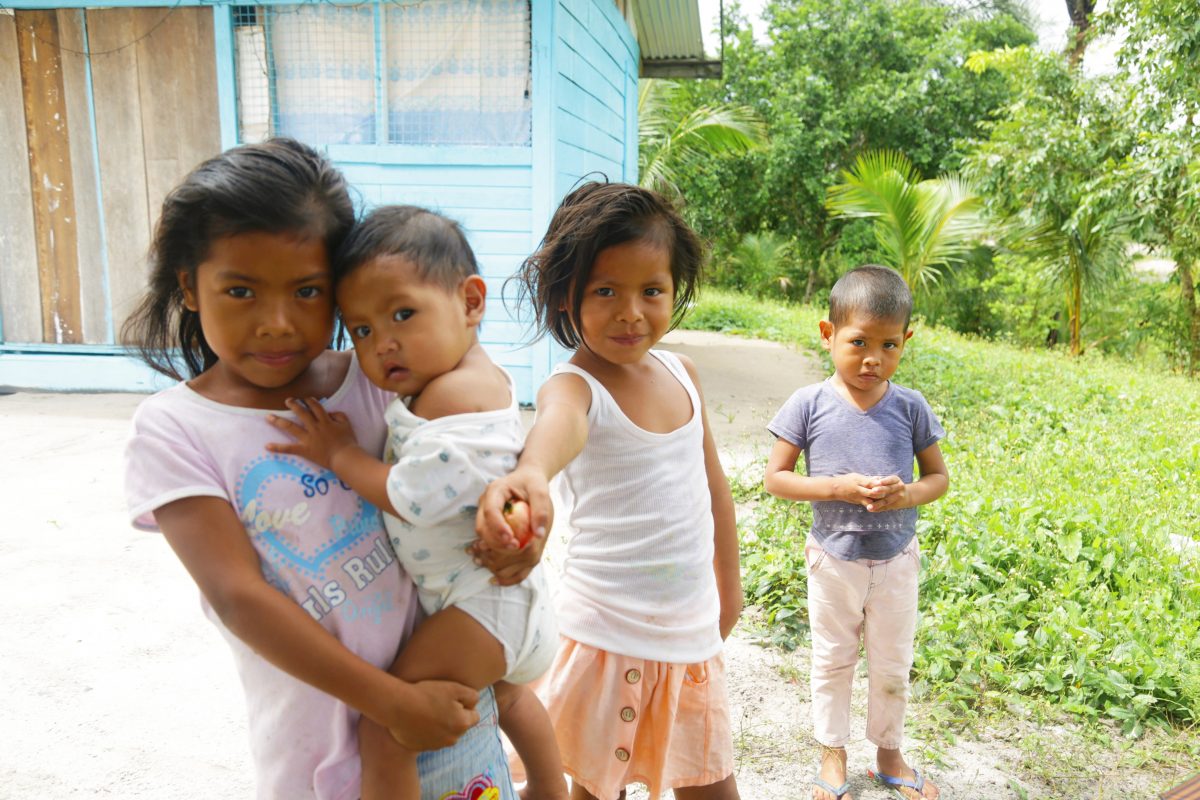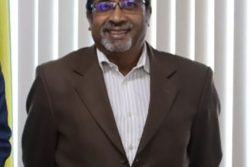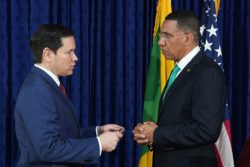Micobie is a picturesque Amerindian settlement two hours outside of Mahdia, which can only be accessed by climbing what are among the steepest and most dangerous hills in Guyana or via the Potaro River. The village was named after the lizards that once frequented the area but are seldom seen today.
A large percentage of the 618 residents are of the Patamona tribe. It was not surprising therefore to learn that the name of the village means lizard in the Patamona language. Micobie is said to have been in existence for over 50 years. The very first people to have settled at Micobie originally lived obliquely opposite, across the Potaro, at Tumatumari. Their village had fertile, thriving farms and a beautiful beach, but this all changed when people began mining in the area, leading to the destruction of community life as well as damage to the beach.
Though they moved to what is known as Micobie a little more than 50 years ago, the people kept their farms at Tumatumari and would take their boats across the river every day to tend to them. There was also once a Guyana National Service training base at Tumatumari.
Stories were shared of trucks and cars not being able to make it up the hills to Micobie. Some reportedly ran right down back, while others flipped over or fell off the sides. Stories of passengers having to disembark the vehicles they were travelling in and walk the rest of the way while the drivers tried to navigate their way up the hills filled my ears. One of the persons to share one of these stories was the driver who had taken me to Princeville just a day or two before in his Toyota 192 model car. Before he shared his story, I had intended to hire him for the trip to Micobie, but after the telling of it, I quickly changed my mind. He had only been driving in the area for three years, having returned from Venezuela.
As it turned out, I managed to contact the man who was supposed to be my designated driver for the trip, a Burtland Scotland, who was referred to as ‘Mr Scotland’ by everyone around. I had more faith in him after I realised that he has been driving around the area for more than a decade. His sort-of-a jeep was tagged ‘Rush’, and was one of the more modern vehicles, though not specifically designed for off-road purposes. Mr Scotland, too, had some stories of his own to share though he said that none were personal experiences.
“I always pray before I take the wheel,” he said and my faith in him was renewed after these words. Mr Scotland is certainly a man with skills which I was aware of even though I closed my eyes halfway through each of our ascents up the dreaded hills. Somehow, I’m sure that none of the skills of the stuntmen or actual drivers in the Fast and Furious movie series could come as close. The hills were not just steep climbs, because of the recent rains, they were slushy and steep.
At every sharp bend or turn, Mr Scotland honked his horn to alert any drivers that might be coming from the other direction to avoid a head-on collision, given the narrowness of the road. At several parts in the road, he stopped as roadwork was ongoing, and workers had dumped hills of red loam along it. He swore under his breath, muttering that what they were supposed to have done in the dry season they chose to do during the wet season which was making the road slushier.
Atop the last hill, we arrived at a barrier that was manually opened and closed. There, drivers are required to pay a small fee of $500 before entering the village. Once in the village, I could see children looking out from houses. Often, the oldest sibling carried the youngest on her/his hip. There were no adults in sight. I later found them along with Micobie’s toshao gathered under a giant benab awaiting the National Toshaos Council (NTC) representatives. They were about to have a village meeting and some of the more prominent people held books in which they had a sort of record of the concerns they wanted to share.
Cleveland Henry is the current toshao of Micobie, a position he has held for a year and six months. “In the early days of moving here it was hard for the children because that was where the school was, and they would have to travel by boat to get there. I was one of the children who attended the school at Tumatumari. We took an hour, sometimes less to get to the site where the school was,” the soft-spoken toshao said. Most of the children stayed at the school’s dorms, travelling home only at the end of the week.
Henry’s major concern was the Potaro River that runs below the hills that Micobie stands on. The river, he said, was polluted from the mercury used by miners. There was a time when the people of Micobie could rely on the Potaro River for water for various purposes, but because of pollution they now source their water from the reservoir in the community. “[Through] the mining they are breaking the buffer zone which is our titled land. We reported them already but these miners, they are close with GGMC [Guyana Geology and Mines Commission]. By the time we call them [the GGMC], they [the miners] get the news before and move,” he said.
“Day before yesterday, the warden went and stop them and last night I hear the dredge start work again,” he added. The toshao wishes that this matter can be looked into soonest.
As regards future developments for the community, Henry said they are looking to do agriculture on a larger scale. For the time being, farming is done on a small scale. They plant specifically ground provision. Work on a farm is currently underway and is still in the beginning phase as villagers are still clearing the four-acre plot designated for planting. Cassava, a major staple, will be planted on most of the plot. Amerindians use to cassava to derive farine, which is widely used among their people, along with cassava bread.
Henry said they have already considered how to market the farine once it is ready. Further conversation with the toshao was hindered as NTC representatives began to arrive for the meeting.
What mining did
I stole Molly Edwards from where she was seated in the small audience. She is one of the few Patamonas who can still speak their language. Shy at first, she smiled and walked with me to the edge of a cliff for us to view the scenic Potaro running below. Her older and bolder sister, Malinda Roberts soon joined us.
As she looked out, Edwards glanced over at Tumatumari, now barren of houses and trees in many places. “This mining started a long time ago,” she said. “Before now, it wasn’t like that. It was forest and land; it had the buffer zone along the river. The mining law says that the buffer zone must not be destroyed as it protects the inland, but this is what they did. It belongs to Micobie, it’s our titled land.”
Edwards hails from a place called Kaburi, also known as 72 Miles in Region Seven (Cuyuni-Mazaruni). She was 16 years old when she along with her parents and other siblings moved to Micobie from Tumatumari. Her grandparents, she said, were already residing at Micobie. Her grandfather, Joseph Roberts of Kurukabaru, North Pakaraima had settled in Tumatumari a long time ago before moving to Micobie. He was one of the people who opened the village.
Edwards loves travelling and was fortunate to be able to do so when her husband, Cornel Edwards, was appointed vice-chairman of Region Eight in 2011. He served one term – four years. During his tenure, he was expected to visit 17 villages in the Pakaraimas every month. Edwards said she went along with him on these visits, usually on an ATV or motorcycle. So far, she has also visited areas in Region One (Barima-Waini) and Region Nine (Upper Takutu-Upper Essequibo).
“Of all the places I’ve visited,” she said, “I would say our Region Eight, in the Pakaraimas is very beautiful. The scenery, the mountains and the savannah, very nice. I visited Kato, Monkey Mountain, Tuseneng, Parama-katoi, Kurukabaru, Kamana, Orinduik, Karasabai and Kopinang,” the Patamona woman said.
Roberts said their grandparents were living at Tumatumari before the Second World War [or before 1939, when the war begun]. “Then we move here before independence [1966]. They told us to come together and find the best land and settle there, and we find Micobie.
“According to the old folks who moved here, they said this was [considered the best] as this was their hunting ground, where they can fish, where they can find their materials for building their houses, where you could find you gold, you diamond, everything was right here. At the time we moved, I was five years old and they were building the hydro at Tumatumari Falls. But it [the hydropower plant] doesn’t work anymore.”
Roberts, it turned out, was the one who penned the written request to occupy the land they now call Micobie. She was 14 years old at the time and one of the few girls who remained in school – the Tumatumari All-Age Government School – which she completed at 17 years old.
“I went to listen to the meeting and the old folks, they didn’t really understand and I was there to listen for them and so.. I go up to the headmaster and tell him everything that they had tell us. I asked the headmaster to help me and I begin to show him demarcation, where and where. They said that we have to get surveyors and I said no. I told them I would take the road as the boundary, the creeks and the river as the boundary that is what I did.
“I wrote the letter to the higher authorities in Georgetown, I can’t remember their names. The people who came in here were some commissioners from Bartica and somebody from Georgetown too. One did name ‘Patfort’ and the other one, ‘Cigar’. By the time we moved here, I was 17 years old.”
The two other persons who assisted Roberts in finding Micobie are now deceased. They were Millicent Williams and Peter Harris.
Over the years, Roberts has served as second captain (deputy toshao, 2005-2008) for a term, second in command to Edwards, who was at one time toshao of Micobie. Roberts was also a councillor twice.
Micobie has three churches – Micobie Cross Culture, Micobie Anglican and Micobie Full Gospel. The sisters are members of the Anglican Church.
Kanaimas
Now 69 years old, Roberts, who is the older sister, farms daily on the other side of the river. As mentioned above, one of the main dishes is farine. At her age, she said, she can no longer undertake the process of making farine. However, she was willing to share the method. “You grate the cassava, matapee it, then parch it on a big pan,” she shared. “After you parch it, you finish making it and all you got to get is your stew to soak it with. You can also [after it is parched] make porridge with it and add your milk; it’s nutritious,” she said.
Near where we stood, a Bina plant blossomed beautifully. The Bina plant is one of the oldest collections of the Amerindian charm plants. Different species of the plant can be used for different purposes, it was shared. Some can be used for goodwill while others can be used for ill-will against enemies. However, neither Edwards nor Roberts knew how or for what to use the Bina plant. The one for ill-will was said to be used by Kanaimas, Amerindians believed to be involved in a ‘higher science’ that allows them to become spirits and hurt people.
The women shared that Kanaimas would sometimes visit their village, while adding that they can tell when a Kanaima visits. Roberts shared that she has several Bina plants herself that she uses as painkillers, quickly adding that they are not the kinds used by Kanaimas.
When I jokingly asked, “How can I be sure I’m not talking to a Kanaima?” the women laughed. And Roberts replied, “Well, you don’t always know when you talking to a Kanaima.” She went on to speak of someone they know, a particular “Kanaima” who frequents the area. “We know him well. I know him since he was a young man and I didn’t know then that he was a Kanaima,” she related. “Eventually, I learn that he was one. I hear that every time this man with people, they dying, so much dead suh at Mahdia and so much dead at this place and that. He came in here sometime, some years ago. The man sport with my aunty and some other people then he said he was going to sleep with this old lady. Exactly as he said, happened and he gone he way. She get sick after and went to Mahdia Hospital; she die two or three days after. They couldn’t find no complaint for she but was that. That was when we were sure that he is a Kanaima.
“The woman, before she died, said that is the same man get her sick. The man is from Kamarang. One of the [village officials] said the next time he [the Kanaima] come here, we must shoot him but we said no. A time is coming when he is going to die; we don’t want to get ourselves in problem. He pass his powers on to his son and some other young people already,” she revealed.
Living in Micobie can be both rewarding and challenging, the sister said. One of their main challenges is transportation. They would like to have a government vehicle for public transportation purposes. They noted that people are usually required to pay some $30,000 for chartered vehicles to Mahdia on a return trip.
Edwards explained that during the previous administration and after her term as toshao, Micobie was given two buses, but because of poor to no maintenance, both have ceased to work.
Her husband was one of the persons under the benab who voiced his concerns to the NTC representatives reflecting on some of the topics aired at the previous meeting. He was one of the villagers who had a book of notes as he kept a record of what was addressed at meetings. After I walked around the village taking photos, he met with me at the cricket pavilion where we took shelter from the rain.
Before we got into his experience of living in Micobie, we talked about his tenure as vice-chairman for Region Eight, North Pakaraima to be specific. “I visited 17 villages in the North Pakaraimas every month. I learn of different ways in communicating with the Amerindians and especially in assisting them in their finances spent on projects. They were better able to manage it with my help,” he said.
“Some villages didn’t know how to budget or prepare work programmes. It was a great experience, but sometimes it was challenging. Every week I had to go with my motorcycle to these villages, rain or no rain. I had to visit every village then report every month. Some [journeys] took me about six hours, some about eight hours to get there. To work in that area, I had to take a plane from Mahdia to there,” he shared.
He considers the North and South Rupununi and the North Pakaraima to be the most beautiful places in all of Guyana. The Edwards family had intended to open a business in one of the villages but was not granted permission by that village council to do so.
Cornel Edwards is farmer and miner. He is a self-employed miner, meaning he mines alone. Every time he goes off to do a bit of mining, he is gone for a fortnight. His recent mining activities found him at Coomacka in Region Ten (Upper Demerara-Upper Berbice). As a farmer, he plants cash crops, ground provision, red beans, bananas and plantains. The last two are mostly for his personal use, but the cash crops he sells to the miners in the area. To be able to farm as he likes, Edwards would stay in a camp close by his farm. Staying near his farm allows him to deal with the acushi ants before they manage to destroy his crops.
At present, Edwards is the chairman in Micobie for sports. Every weekend, the youths are involved small competitions in football and cricket. The Micobie ground is used on a daily basis. Edwards has made requests to the Ministry of Youth and Sports to provide the community with the necessary sports gears as well as floodlights. In addition, he would like for another pavilion to be built, as the current one cannot even accommodate a quarter of the 600-plus villagers.
The man shared that instead of chartering a vehicle from Mahdia to the village, persons coming from Georgetown can also stop along the Linden/Lethem trail at the head of the route to the village where they could call ahead to have a taxi waiting for them. The fare from Georgetown to the head of the road to Micobie is the same $10,000. This way it is cheaper to get to the village, as taxis can be chartered one way at a cost of $5,000.
I pointed out to him that it was still expensive. He replied, “It would be expensive for you but by we live in the interior part, we don’t say it is expensive. If we working with the government, we would have said that as the pay is less but in the mining community, it’s cheap.”
He noted too that they have made requests for an ambulance to be stationed at the Micobie Health Post. But according to the man they were told that they will need to rely on the Mahdia Hospital Ambulance, which, he noted, will take twice as long, almost four hours to have a patient transferred from Micobie to the hospital whereas if they had their own ambulance, it would take half that time. Government officials, he said, had made excuses about the road not being in proper condition for an ambulance also but years after these excuses, the people of Micobie are still awaiting better roads.
















